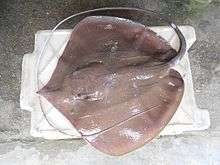Whitenose whipray
The whitenose whipray or Bleeker's whipray (Himantura uarnacoides) is a species of stingray in the family Dasyatidae native to the eastern Indian Ocean and the western central Pacific Ocean, where it is found in shallow water including estuaries.
| Whitenose whipray | |
|---|---|
 | |
| Scientific classification | |
| Kingdom: | |
| Phylum: | |
| Class: | |
| Subclass: | |
| Order: | |
| Family: | |
| Genus: | |
| Species: | H. uarnacoides |
| Binomial name | |
| Himantura uarnacoides | |
| Synonyms[2] | |
|
Trygon uarnacoides Bleeker, 1852 | |
This species was first described by the Dutch ichthyologist Pieter Bleeker in 1852. He was an army surgeon who worked for 20 years for the Dutch East India Company in Indonesia, amassing a collection of over 12,000 fish which he took home with him when he returned to Holland. They are mostly lodged in the Natural History Museum in Leiden.[3]
Distribution and habitat
The whitenose whipray is found in the eastern Indian Ocean and the western central Pacific Ocean, its range extending from India to Malaysia and Indonesia; it is a demersal fish and is usually found over soft substrates in water that is shallower than 30 m (100 ft), including the lower reaches of rivers and estuaries.[1][4] One individual was found in a saltwater lagoon.[1]
Uses
The species is caught in large quantities by bottom trawling, demersal tangle netting, trammel netting, and Danish seine fishing in India, Malaysia, and Indonesia. The flesh is consumed fresh or preserved by salting and drying, and the vertebrae are dried and exported to the Far East. The skins are dried and used in the manufacture of bags, wallets, belts, and shoes.[1]
Status
This demersal whipray is threatened by overexploitation, as it is fished intensively over much of its range. In Indonesia, fishing vessels must travel for much greater distances to find acceptable quantities of fish. In India, too, where it is heavily fished, the catch rate is also declining from overfishing, as well as pollution and coastal degradation. Little is known of this fish's reproductive rate, but it is likely to be similar to other elasmobranchs. So, the International Union for Conservation of Nature has assessed this fish as a "vulnerable species".[1]
References
- White, W.T.; Manjaji, B.M.; Fahmi (2009). "Himantura uarnacoides". IUCN Red List of Threatened Species. 2009. Retrieved 4 July 2016.CS1 maint: ref=harv (link)
- Bailly, Nicolas (2015). "Himantura uarnacoides (Bleeker, 1852)". WoRMS. World Register of Marine Species. Retrieved 4 July 2016.
- Watkins, Michael; Beolens, Bo (2015). Sharks: An Eponym Dictionary. Pelagic Publishing Ltd. pp. 14–15. ISBN 978-1-78427-037-7.
- " Himantura uarnacoides (Bleeker, 1852)". FishBase. Retrieved 8 July 2016.
